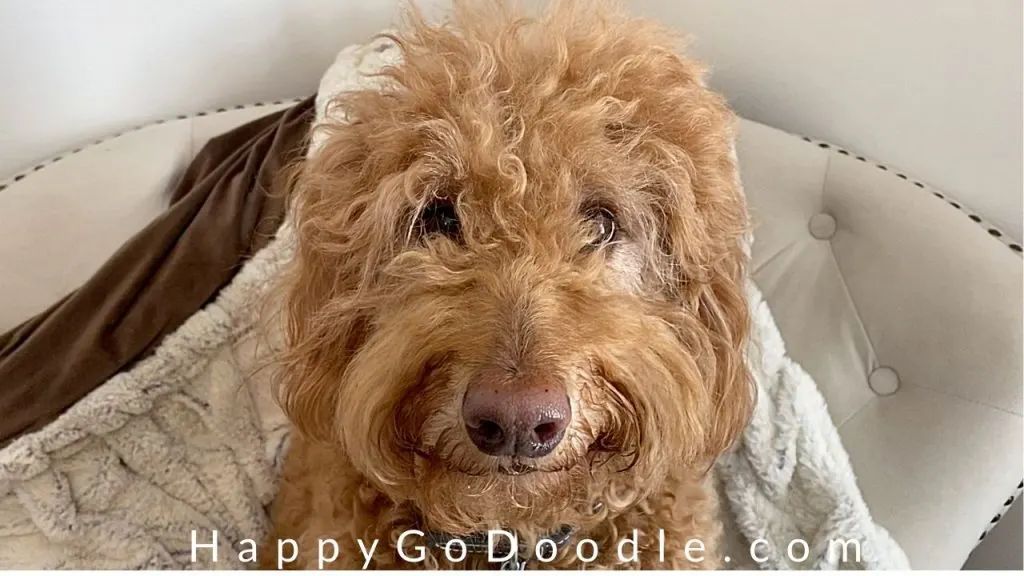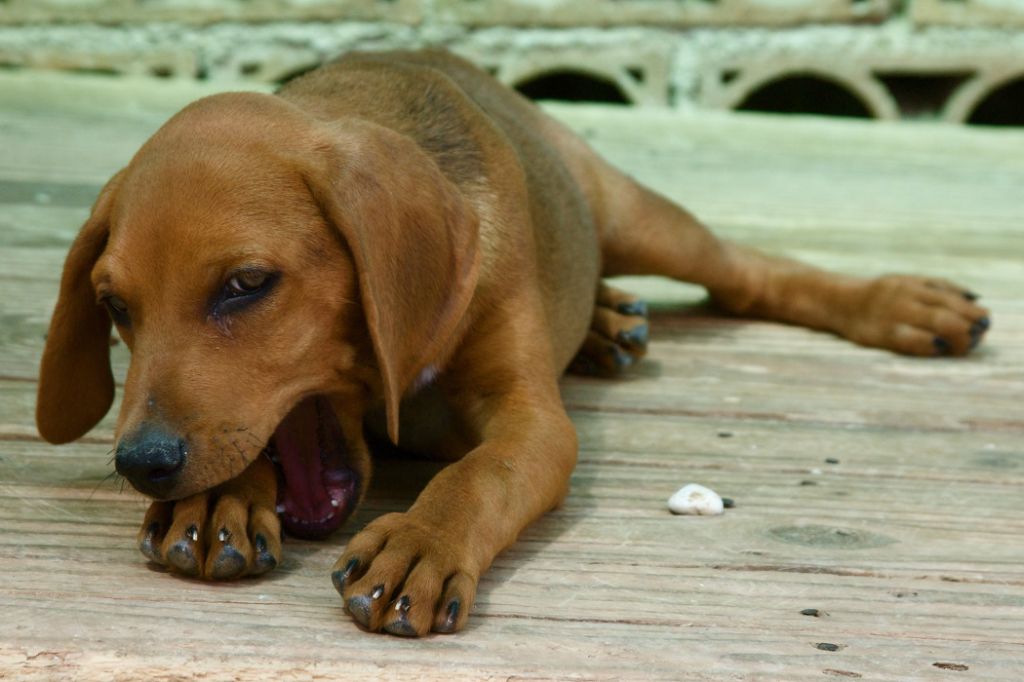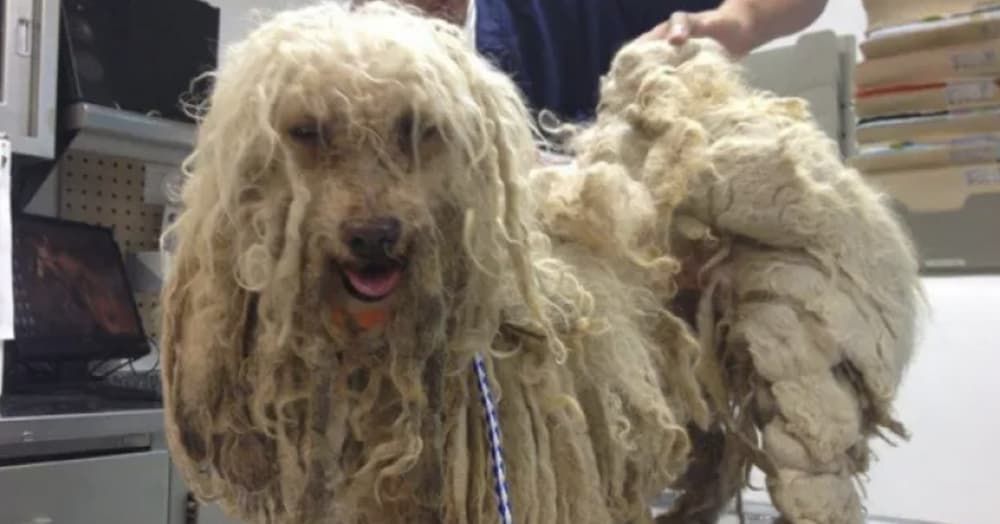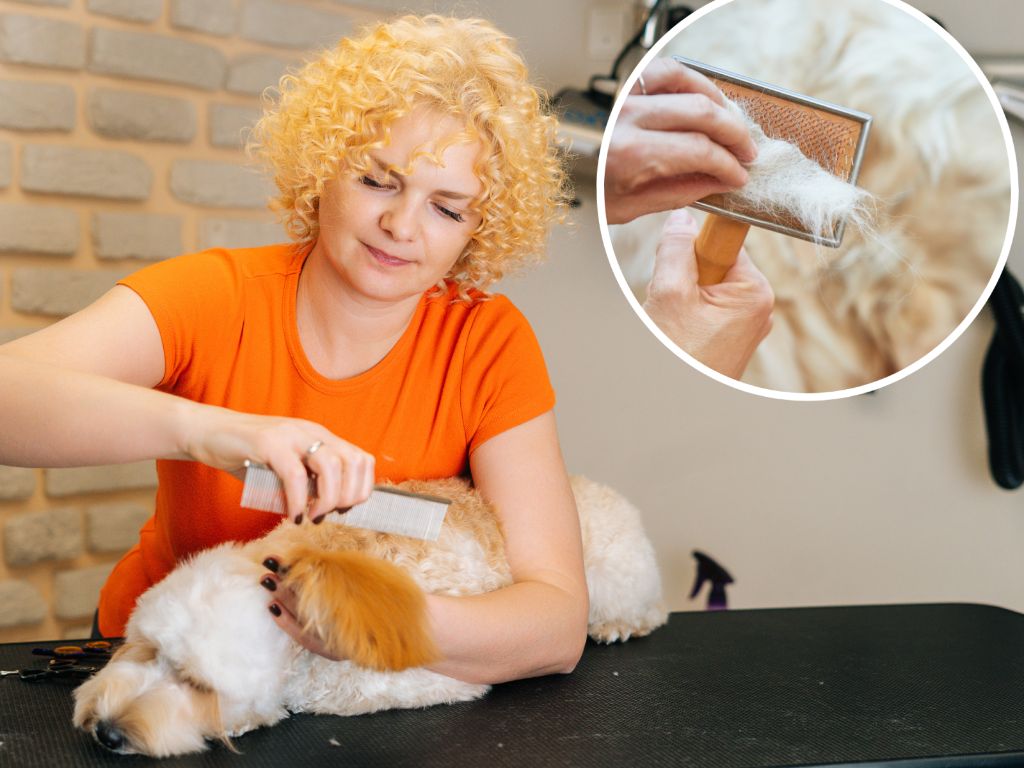What is Matted Dog Hair?

Matted dog hair refers to tightly knotted clumps or ropes of fur that form in a dog’s coat. Matting occurs when loose hairs, dirt, and debris become trapped in a dog’s thick or curly coat and tangle together. This causes clumps of hair to form into dense masses that are matted close to the dog’s skin.
Matting is caused by a number of factors, including lack of regular brushing, excessive shedding, long hair, skin conditions, aging, and neglect. Dogs with long, thick, or curly coats are more prone to matting, such as Poodles, Shih Tzus, Lhasa Apsos, and Maltese.
Matted fur commonly occurs in areas that the dog cannot reach to groom themselves, such as behind the ears, under the arms, on the belly, and on the back of the legs. However, severe matting can cover a dog’s entire body if left unattended for long periods.
Is Matting Painful for Dogs?
Matted fur can cause significant discomfort and pain for dogs. The tight, knotted fur pulls and binds the skin, causing irritation, inflammation and even sores due to restricted blood flow. Dogs with matted coats are also at high risk for developing skin infections under the matted fur, where dirt, debris and moisture can be trapped against the skin and lead to fungal or bacterial growth.

According to veterinary experts, mats cause the skin to become overly sensitive and tender to the touch. The constant pulling and tightness of the matted fur can make normal activities painful for the dog. Even mild matting is uncomfortable for a dog, as it restricts the skin’s ability to flex and breathe. Severe matting exacerbates these issues and causes even greater pain and distress.
Veterinarians emphasize the importance of regular brushing and grooming to prevent matting in dogs. Keeping the fur free of knots and tangles will spare the dog unnecessary discomfort and potential health issues. If matting has already occurred, gently working out the mats or seeking professional grooming care is recommended to minimize pain. Allowing severe matting to persist can be considered neglect, as it has clear negative impacts on a dog’s welfare.
When Does Matting Become Neglect?

Matting becomes neglect when owners chronically fail to sufficiently groom and maintain their dog’s coat. Minor occasional matting is normal, but severe or excessive matting indicates an owner is neglecting proper grooming and care. Signs of chronic neglectful matting include:
- Mats covering large portions of the dog’s body
- Mats that are very dense, tight, and difficult to remove
- Mats that cause visible skin irritation, sores, infections
- Mats that restrict joint movement or cause difficulty walking
- Mats soaked with feces, urine, or pus
- Mats that have been present for months at a time
- No evidence of recent or regular grooming
According to veterinary experts, mats that encircle a dog’s legs or body can severely restrict blood flow and damage tissue (Source). Allowing mats to advance to this state constitutes neglect and abuse. While every dog’s coat is different, chronic, excessive matting causing pain or injury is never acceptable.
Dangers of Severe Matting
Severe matting can pose serious health risks and dangers to dogs. As clumps of hair become tightly wound and bonded together, they pull and tug at the skin, often leading to painful sores and irritation. The matted hair also traps moisture, dirt, and debris against the skin, causing infections. Bacteria and fungi can thrive in this moist, dirty environment, worsening existing sores and potentially spreading infection throughout the body.
Matts also restrict air circulation to the skin, causing the area to overheat. This can lead to painful hot spots on the skin. The dog may constantly bite and lick at the matted areas trying to relieve their discomfort. Severely matted hair can cut off blood supply to extremities like the tail, ears, or legs. Loss of circulation combined with trapped waste and moisture creates an ideal environment for maggots or parasites to infest the skin underneath mats.
Thick mats and knots also significantly limit a dog’s mobility and range of motion. Matted hair around joints pulls and restricts movement, making it difficult for the dog to walk, run, or play. Mats on the paws can make it painful to stand or walk. Severe matting essentially immobilizes a dog, impacting their quality of life.
According to PetWow.com, “Severe matting may limit your pet’s ability to move freely, especially if the hair on their feet or legs becomes matted to adjacent areas.” Preventing and promptly removing mats is crucial to dogs’ health and wellbeing.
How to Prevent Matting
Regular brushing and grooming is key to preventing matts in a dog’s coat. Dogs with long hair should be brushed thoroughly at least every other day. Short-haired dogs require brushing once or twice a week. Be sure to brush all the way down to the skin and pay close attention to areas where matts tend to form, like behind the ears, under the legs, and near the rear.[1]
Keeping your dog’s coat trimmed regularly will also help prevent matting. Long hair is more prone to tangles and knots, so keeping it trimmed to a manageable length makes brushing easier and reduces matting. Ask your groomer to use techniques like thinning shears to remove bulk without dramatically shortening the length.
Frequent bathing and conditioning can help loosen dirt and debris that gets trapped in the coat and causes matts. Use a moisturizing shampoo and conditioner formulated for dogs. Work the conditioner thoroughly into the coat and let it sit for a few minutes before rinsing. After bathing, make sure to completely dry the coat with a dryer on a cool setting.
How to Remove Minor Matts
When dogs get small, minor matts in their coat, there are some gentle techniques you can try at home to remove them before they get tighter and more difficult to brush out.

Start by spraying the matted area with a detangling spray or working some cornstarch into the mat. Let it sit for a few minutes to help loosen up the hair. Then, very gently work at the mat with a slicker brush or comb, starting at the ends of the hair and slowly brushing up towards the base. Take your time and be very gentle, never forcing or pulling on the mat. The detangler and gentle brushing action should allow the hairs to start separating.
You can also try working the mat out in sections, gently teasing apart a little bit at a time. Smaller matts may take some patience, but with a light touch you can often brush them out without cutting the hair. Avoid forcefully ripping or cutting matts out, as this can be painful and stressful for the dog.
For minor matting, never use scissors or shears yourself, as it risks cutting the dog’s skin if done improperly. Seek professional grooming help if the mats do not brush out. With care and regular brushing, minor matts can often be managed at home without cutting your dog’s hair.
Sources:
https://andreaarden.com/dog-health/how-to-remove-mats-from-your-dogs-coat/
When to Seek Professional Help
When dogs develop large, tight mats, it is best to seek professional grooming. Trying to remove severe matting at home can be very painful for the dog and risks cutting their skin (Vetericyn). Professionals have the proper tools and experience to humanely remove mats.
It is never recommended to shave a dog’s matted fur down to the skin. The tight mats can trap moisture and irritate the skin underneath. Shaving can expose already inflamed or wounded skin and cause more discomfort for the dog.
A professional groomer will use techniques like dematting rakes, high velocity dryers, and clippers to gently loosen and remove the mats little by little. Though the process can take time, it is much less traumatic for the dog when done properly by someone trained in safe dematting procedures.
Signs of Abuse
The presence of extreme matting in a dog is a hallmark sign of neglect. Matting occurs when loose fur becomes knotted together into tight clumps. This causes significant discomfort and can lead to painful skin lesions, infections, and parasite infestations (Source). As mats tighten they can cut off circulation, leading to nerve damage and tissue death.
Owners allowing dogs to reach a severely matted state are usually not providing adequate care in other areas as well. Signs of neglect include dogs left in dirty environments, lack of access to clean food and water, overgrown nails that impair walking, and untreated medical issues (Source). Severely matted dogs are likely suffering immensely and require immediate veterinary intervention.
If an owner is unwilling or unable to provide this care, it may qualify as neglect or outright abuse. In many areas, animal welfare laws allow legal intervention when animals are deprived of basic needs like grooming, veterinary treatment, sanitary living conditions and adequate nutrition and hydration.
What to Do About Suspected Abuse
If you suspect a dog’s severe matting is a sign of neglect or abuse, it’s important to report it to the proper authorities. Here are some steps you can take:
Contact local animal control or law enforcement. Provide details on the dog’s condition and living situation. Officers can investigate and determine if intervention is needed (ASPCA).
Reach out to animal welfare organizations. Groups like the ASPCA and Humane Society have hotlines to report cruelty and can provide guidance. They may get involved directly or assist with legal support (This Dog’s Life).
Offer to testify in court. Neglect cases often end up in the legal system. Providing a witness statement on the dog’s matting can help demonstrate the severity. Vet reports also provide key evidence.
Check back on the dog’s status. Even if a dog is removed from a neglectful situation, it may still need care and grooming. You can contact animal control or shelters to follow up on its recovery.
Providing Proper Care
As a dog owner, it’s important to provide proper coat care to keep your pet comfortable and healthy. This involves regular grooming to prevent matting and properly removing mats if they occur. According to VCA Animal Hospitals, dogs with long coats need daily brushing, especially in areas prone to tangles.
For minor mats, you can try working them out gently with your fingers or a dematting comb. Never cut mats out with scissors yourself, as this can injure the skin. For severe matting, seek professional grooming services. Groomers have the proper tools and training to humanely remove mats without harming the dog.
It’s best to establish a regular grooming routine, such as brushing a few times per week. Check for mats often by running your hands over the coat and skin. Keeping the coat maintained will help avoid discomfort and skin issues. Provide a healthy diet and inspect for parasites as well. Address any signs of skin problems promptly. With proper care, you can keep your dog’s coat looking and feeling its best.